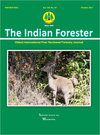Dung Beetles (Scarabaeidae): an Efficient Model for Long Term Ecological Monitoring
DOI:
https://doi.org/10.36808/if/2017/v143i10/119378Abstract
No Abstract.References
Filgueiras K.C.B., Tabarelli M., Leal R.I., Vaz-de-Mello Z.F., Peres C.A. and Luciana Iannuzzi L. (2016). Spatial replacement of dung beetles in edge-affected habitats: biotic homogenization or divergence in fragmented tropical forest landscapes?. Diversity and Distributions, 22:400-409
Batista M.C., Lopes G.S., Marques P.J.L. and Teodoro V.A. (2016).The dung beetle assemblage (Coleoptera: Scarabaeinae) is differently affected by land use and seasonality in northeastern Brazil. Entomotropica, 31(13):95-104
De Oca M.E. and Halffter G. (1998). Invasion of Mexico by Two Dung Beetles Previously Introduced Into the United States. Studies on Neotropical Fauna and Environment, 33:37-45
Davis A.J., Holloway J.D., Huijbregts H., Kirk-Spriggs A.H. and Sutton S.L. (2001). Dung beetles as indicators of change in the forests of northern Borneo. J. Applied Ecology, 38:593-161
Davis A.L.V., Scholtz C.H. and Deschodt C. (2008). Multi-scale determinants of dung beetle assemblage structure across abiotic gradients of the Kalahari-Nama Karoo ecotone, South Africa. J. Biogeography, 35:1465-1480
Dufrene M. and Legendre P. (1997). Species assemblages and indicator species: the need for a flexible asymmetrical approach. Ecological Monographs, 67:345-366
Estrada A., Coates-Estrada R., Dadda A.A. and Cammarano P. (1998). Dung and carrion beetles in tropical rain forest fragments and agricultural habitats at Los Tuxtlas, Mexico. J. Tropical Ecology, 14:577-593
Escobar F., Halffter G. and Arellano L. (2007). From forest to pasture: an evaluation of the influence of environment and biogeography on the structure of dung beetle (Scarabaeinae) assemblages along three altitudinal gradients in the Neotropical region. Ecography, 30:193208
Gardner T.A., Barlow J., Araujo I.S., Avila-Pires T.C., Bonaldo A.B., Costa J.E., Esposito M.C., Ferreira L.V., Hawes J., Hernandez M.I., Hoogmoed M.S., Leite R.N., Lo-Man-Hung N.F., Malcolm J.R., Martins M.B., Mestre L.A., Miranda-Santos R., Overal W.L., Parry L., Peters S.L., Ribeiro-Junior M.A., da Silva M.N., da Silva M.C. and Peres C.A. (2008). The cost-effectiveness of biodiversity surveys in tropical forests. Ecological Letters, 11:139-150
Halffter G. and Favila M.E. (1993). The Scarabaeinae (Insecta: Coleoptera) an animal group for analyzing, inventorying, and monitoring biodiversity in tropical rainforest and modified landscapes. Biology International, 27:15-21
Halffter G. and Arellano L. (2002) Response of dung beetle diversity to human-induced changes in a tropical landscape. Biotropica, 34:144-154
Han Y., Kwon O. and Cho Y. (2015). A study of bioindicator selection for long-term ecological monitoring. Journal of Ecology and Environment, 38(1):119-122
Klein B.C. (1989). Effects of forest fragmentation on dung and carrion beetle communities in central Amazonia. Ecology, 70:1715-1725
Larsen T.H., Lopera A. and Forsyth A. (2008). Understanding trait-dependent community disassembly: dung beetles, density functions, and forest fragmentation. Conservation Biology, 22(5):1288-1298
Lobo M. J., Lumaret J. and Jay-Robert P. (2002). Diversity, distinctiveness and conservation status of the Mediterranean coastal dung beetle assemblage in the regional natural park of the Camargue (France). Diversity and Distributions, 7(6):257-270
Mcgeoch M.A., Van Rensburg B.J. and Botes A. (2002). The verification and application of bioindicators: a case study of dung beetles in a savanna ecosystem. J. Applied Ecology, 39:661-672
Montes de Oca E. and Halffter G. (1998). Invasion of Mexico by Two Dung Beetles Previously Introduced into the United States. Studies on Neotropical Fauna and Environment, 33:37-45
Menéndez R., González-MegÃas A., Jay-Robert P. and Marquéz-Ferrando R. (2014). Climate change and elevational range shifts: evidence fromdung beetles in two European mountain ranges. Global Ecology and Biogeography, 23:646-657.
Nichols E., Spector S., Louzada J., Larsen T., Amezquitad S. and Favila M.E. (2008). Ecological functions and ecosystem services provided by (Scarabaeinae) dung beetles. Biological Conservation, 141:1461-1474
Nichols E., Gardner T.A., Peres C.A. and Spector S. (2009). Co-declining mammals and dung beetles: an impending ecological cascade. Oikos, 118:481-487
Noss R.F. (1990). Indicators for monitoring biodiversity: a hierarchical approach. Conservation Biology, 4:335-364
Numa C., Verdu R.J., Sanchez A. and Galante E. (2009) Effect of landscape structure on the spatial distribution of Mediterranean dung beetle diversity. Diversity and Distributions, 15:489-501
Numa C., Lobo M.J. and Verdu R.J. (2012) Scaling local abundance determinants in mediterranean dung beetles. Insect Conservation and Diversity, 5:106-117
ScholtzC.H.,DavisA.L.V.andKrygerU.(2009). Evolutionary Biology and Conservation of Dung Beetle. Pensoft publisher, 567pp
Shahabuddin Hasanah U. and Elijonnahdi (2014). Effectiveness of dung beetles as bioindicators of environmental changes in land-use gradient in Sulawesi, Indonesia. Biotropia, 21(1):48-58
Downloads
Downloads
Published
How to Cite
Issue
Section
License
Unless otherwise stated, copyright or similar rights in all materials presented on the site, including graphical images, are owned by Indian Forester.





